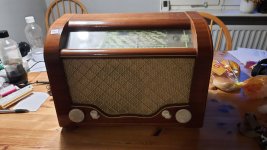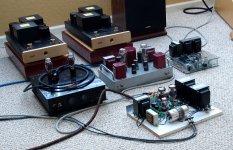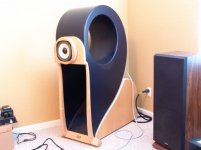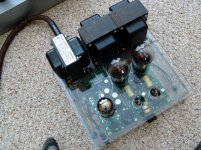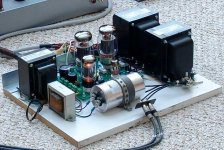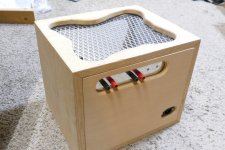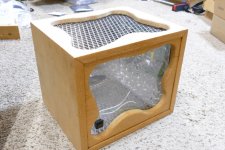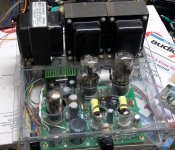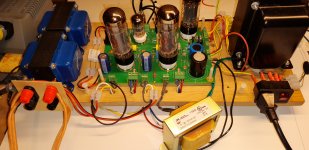Are the transformers attached to earth? Probably they ought to be attached to the earth block you have just for safety's sake. Could also affect the screening of the power transformer.
You could maybe experiment by elevating ground from earth, just as part of the process of elimination. You can use a resister, like 10ohms to 100ohms, and see if that helps.
You could maybe experiment by elevating ground from earth, just as part of the process of elimination. You can use a resister, like 10ohms to 100ohms, and see if that helps.
My amp are at this state not perfect, the humms annoy me. However am I confident that this forum will guide me to an acceptable level. There are some final tweaks to be done....
The "hums" will most likely dissapear once the assembled amp is installed into an appropriate metal chassis.
Proper shielding is mandatory, particularly with tube equipment, because tube circuits are high-impedence circuits, easily prone to interference such as nearby electrical fields of very small levels.
Floating that circuitry in the open air is not smart, safe, or going to be successful.
I'm going for a wood box, so metal shielding are not an solution.
I have ordered a choke (Hammond 159Q) and 2x100uF capacitors. This will hopefully solve the issue. Unless I introduce a new problem. My friends who understand electronic better than me warns for oscillations when combining resistors, capacitors and inductors.
Elevating earth with an resitor: ain't the purpose of earth to be the shortest way if something goes wrong?
I have ordered a choke (Hammond 159Q) and 2x100uF capacitors. This will hopefully solve the issue. Unless I introduce a new problem. My friends who understand electronic better than me warns for oscillations when combining resistors, capacitors and inductors.
Elevating earth with an resitor: ain't the purpose of earth to be the shortest way if something goes wrong?
Attachments
The "hums" will most likely dissapear once the assembled amp is installed into an appropriate metal chassis.....Floating that circuitry in the open air is not smart, safe, or going to be successful.
It was determined earlier by removing the driver tube that the hum is power supply related. If this is indeed the case no amount of shielding will fix it. It was stated in post #5 here, that a choke in the power supply will likely be needed since the builder is in a 50 Hz country:
Do I really need a choke?
There is one other possibility that I forgot to mention. Remove the output tubes from the amp and turn the amp on. I there is still hum, it's from magnetic coupling between the power transformer and the OPT's, since without the tubes there is no other path into the OPT.
I agree that tube amp circuitry in open air is not safe, however it can be successful. I have built several tube amps in wood or Lexan boxes with no metal. The electrical parts do need to be covered as to prevent shocks.
The Lexan amp seen here is dead quiet when connected to 106 dB Lowther based horn speakers. So is the "open air" test SSE. The results might have been different on a 50 Hz power source.
Having owned a Carver M-400 "Cube" amp many years ago, I decided to build a "Tube Cube" about 14 years ago. It contained two of my SPP boards built for 6CW5 tubes. Each board had it's channels wired in parallel for 60 watts of mono block power. Two such mono blocks were stuffed into into the tiny Cube, each powered from its own Antek Toroidal OPT. The two Anteks were stacked on top of each other with EL (Electro-Luminescent) wire wrapped through their cores. The wire was fed from the plates of the output tubes via simple RC filters for multi colored light effects that "danced to the music." That is also the reason for the abundance of shiny diamond plate metal inside the wood and Lexan box.
I called the glowing transformers the "Tubelab Sonic Reactor," two core version. There was a 4 core version that was intended for use as an OPT in a guitar amp with 8 output tubes, but that amp never got built. The 4 core "Sonic Reactor" is still in a box around here somewhere.
This amp was my daily driver amp connected to my PC for a couple years, until as usual for me, I made a new toy, and this amp wound up on the shelf. It was also dead quiet. Several years later it got robbed for it's OPT's, then most of the other parts over time. The "Tube Cube" box will be seen again, most likely with an UNSET board inside.
The light show may not reappear since the novelty wore off and it became quite annoying. If it returns, there will be an OFF switch. The 4 core guitar amp with lights may be cool though.
Attachments
I'm going for a wood box, so metal shielding are not an solution.
I have ordered a choke (Hammond 159Q) and 2x100uF capacitors. This will hopefully solve the issue. Unless I introduce a new problem. My friends who understand electronic better than me warns for oscillations when combining resistors, capacitors and inductors.
Chokes are good investments.
But asides from being in a wooden housing, what's wrong with lining it inside with basic metal shielding to insure silence and immunity to outside interference?
I've built enough of amps/preamps to know that it's a smart consideration.
It is annoying that my amp has the humm, why me when I tried to build it as described on the SSE-site? While I’m waiting (arrival today according to DHL) for the choke, did I review my shopping list to figure out if I have used wrong parts somewhere, especially in the power supply. I found a few deviations from the list of recommended parts on the SSE-site.
C1, 47uf 500V Electrolytic cap
Recommended (not in stock): P7442-ND
I ordered: 4713PHBK-ND
C2: 120uF 500V Electrolytic cap
Recommended (not in stock): P7451-ND
I ordered: 1189-2017-ND
Both replacemtns are of same type and close in specification so I don’t think this can be it. Or are I missing something?
One cap that are slight out of spec are C12 / C22, the ripple current are not the same. However this cap are only used for feedback coupling?
Recommended (not in stock): P10334-ND
I ordered: 565-2012-ND
Next thought: Most SSE are build in USA (I assume), are the differences in 50 vs 60 Hz something to be considered while designing the power supply? There are a change by 20% in frequency and therefore a harder work for the capacitor C1 / C2 to reduce the ripple in the 50Hz grid.
C1, 47uf 500V Electrolytic cap
Recommended (not in stock): P7442-ND
I ordered: 4713PHBK-ND
C2: 120uF 500V Electrolytic cap
Recommended (not in stock): P7451-ND
I ordered: 1189-2017-ND
Both replacemtns are of same type and close in specification so I don’t think this can be it. Or are I missing something?
One cap that are slight out of spec are C12 / C22, the ripple current are not the same. However this cap are only used for feedback coupling?
Recommended (not in stock): P10334-ND
I ordered: 565-2012-ND
Next thought: Most SSE are build in USA (I assume), are the differences in 50 vs 60 Hz something to be considered while designing the power supply? There are a change by 20% in frequency and therefore a harder work for the capacitor C1 / C2 to reduce the ripple in the 50Hz grid.
Last edited:
The Hammond 159q solved the issue. At least to a point to where the ripple are smaller than what my DVM can measure (<1mVAC). The hum is still initially there and disappears after a minute or so.
If I shut down the ventilation in the house and put my ear close to the speaker can I here a waugh humm, I can live with that 🙂
I tried with extra capacitors of 100uF and 200uF, no mayor change and I think 200uF stresses the rectifier more than necessary, it takes 30s to build up the B+. I leave them out until I change my mind.
Finally can I start to build the enclosure, ad the triode/UL and CFB switch, change the volume pot etc.
If I shut down the ventilation in the house and put my ear close to the speaker can I here a waugh humm, I can live with that 🙂
I tried with extra capacitors of 100uF and 200uF, no mayor change and I think 200uF stresses the rectifier more than necessary, it takes 30s to build up the B+. I leave them out until I change my mind.
Finally can I start to build the enclosure, ad the triode/UL and CFB switch, change the volume pot etc.
Attachments
- Home
- More Vendors...
- Tubelab
- SEE: Severe hum
